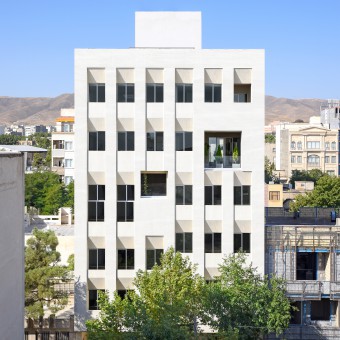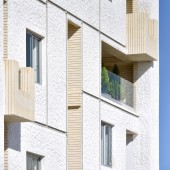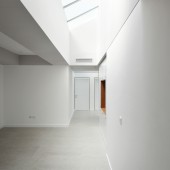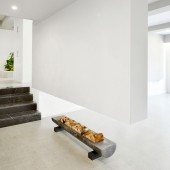
| THE AWARD |
| CATEGORIES |
| REGISTRATION |
| SUBMIT YOUR WORK |
| ENTRY INSTRUCTIONS |
| TERMS & CONDITIONS |
| PUBLICATIONS |
| DATES & FEES |
| METHODOLOGY |
| CONTACT |
| WINNERS |
| PRESS ROOM |
| GET INVOLVED |
| DESIGN PRIZE |
| DESIGN STORE |
| THE AWARD | JURY | CATEGORIES | REGISTRATION | PRESS | WINNERS | PUBLICATIONS | ENTRY INSTRUCTIONS |
16 The Moment Residential by Hosein Ebrahimzade |
Home > Winners > Design #159166 >Interview |
 |
|
FS: What is the main principle, idea and inspiration behind your design?
HE: The main principle, idea, and inspiration behind our design are rooted in the examination of residential architecture from the 1950s and 1960s in Iran. We employed the principles and alternatives from this era to address the project's challenges.
FS: What has been your main focus in designing this work? Especially what did you want to achieve?
HE: The main goal and focus of this project was to strive for families independence while maintaining connections with each other.
FS: What are your future plans for this award winning design?
HE: Currently, this building is operational. The only remaining task is its maintenance and upkeep.
FS: How long did it take you to design this particular concept?
HE: This is a continuation of my studies on residential fabrics, but it specifically took six months to complete it.
FS: Why did you design this particular concept? Was this design commissioned or did you decide to pursuit an inspiration?
HE: This design was a combination of inspirations and client requirements. Therefore, it continued my studies on residential buildings, which coincided with this timely commission.
FS: Is your design being produced or used by another company, or do you plan to sell or lease the production rights or do you intent to produce your work yourself?
HE: This project was constructed by our office, and the sales and allocation of the residential units were also handled by our team.
FS: What made you design this particular type of work?
HE: As I mentioned before, this project is a continuation of my studies on residential buildings. I aimed to develop an effective model suited to the current socio-cultural context of Iran.
FS: Where there any other designs and/or designers that helped the influence the design of your work?
HE: Yes. As I mentioned earlier, In Iranian architecture, such types of apartments were commonly produced, especially in the 1350s(SH). Many works were done in this era, and this project has been developed under their influence.
FS: Who is the target customer for his design?
HE: As mentioned earlier, this project had a specific client, but the main goal was to use a prototype for public use.
FS: What sets this design apart from other similar or resembling concepts?
HE: What sets this project apart is the use of different types of units across the building's floors, which is not common in contemporary construction situation in Iran.
FS: How did you come up with the name for this design? What does it mean?
HE: It's a tough one. I can't explain exactly what the reason for this name was, but usually when naming projects, I focus on the mental and emotional states at that moment.
FS: Which design tools did you use when you were working on this project?
HE: In the design process of this project, common architectural software was used. SketchUp was used for the 3D modeling, and AutoCAD was used for the construction drawings.
FS: What is the most unique aspect of your design?
HE: The most important aspect of this project, which we can attribute this adjective to, is that there is a paradox between the interior and exterior. The exterior appears simple and modest, while the interior has a complex structure.
FS: Who did you collaborate with for this design? Did you work with people with technical / specialized skills?
HE: The tasks of this project were carried out by a team, so our colleagues in the technical and executive departments of our office advanced the technical and executive aspects of this project.
FS: What is the role of technology in this particular design?
HE: In fact, no specific technology was used in this project. Only conventional construction techniques common in the current situation in Iran were used.
FS: Is your design influenced by data or analytical research in any way? What kind of research did you conduct for making this design?
HE: As mentioned earlier, this project has been influenced by the examination of various apartment typologies in Iran over the past 40 years. Detailed designs and urban planning maps of the city of Mashhad were reviewed, and based on these, efforts were made to reach a more accurate pattern in the building.
FS: What are some of the challenges you faced during the design/realization of your concept?
HE: One of the serious challenges in this project was accommodating various agreements with the client and their children, all of whom were future residents of the project. This aspect also involved planning for sales. Overall, managing financial issues was one of the most important challenges in this project.
FS: How did you decide to submit your design to an international design competition?
HE: My reason for participating in this competition was to test this idea and concept for my future projects.
FS: What did you learn or how did you improve yourself during the designing of this work?
HE: The most important thing I learned from this project was the impact of changing plan types on the project's economy and construction tectonics.
FS: Any other things you would like to cover that have not been covered in these questions?
HE: No,thanks.
FS: Thank you for providing us with this opportunity to interview you.
A' Design Award and Competitions grants rights to press members and bloggers to use parts of this interview. This interview is provided as it is; DesignPRWire and A' Design Award and Competitions cannot be held responsible for the answers given by participating designers.
| SOCIAL |
| + Add to Likes / Favorites | Send to My Email | Comment | View Press-Release |





